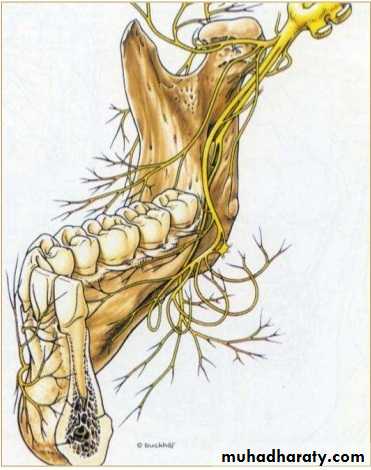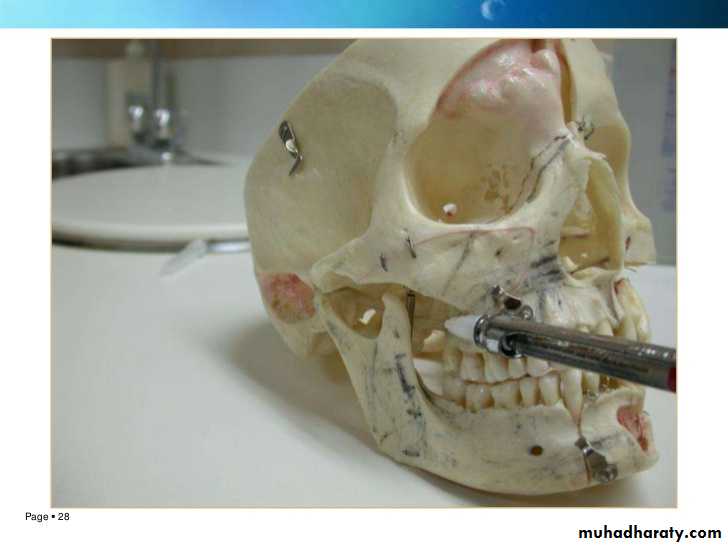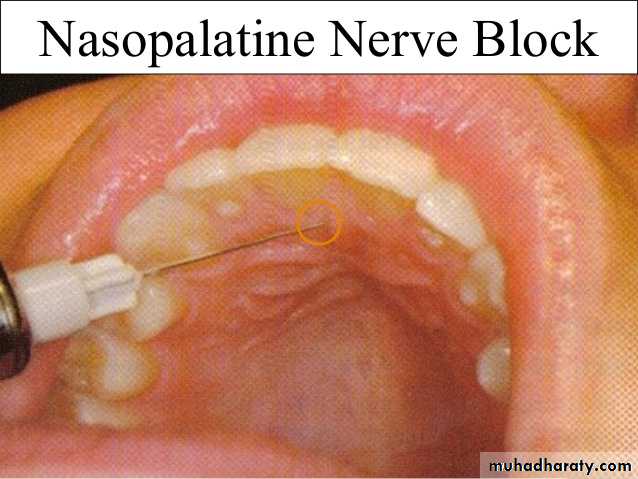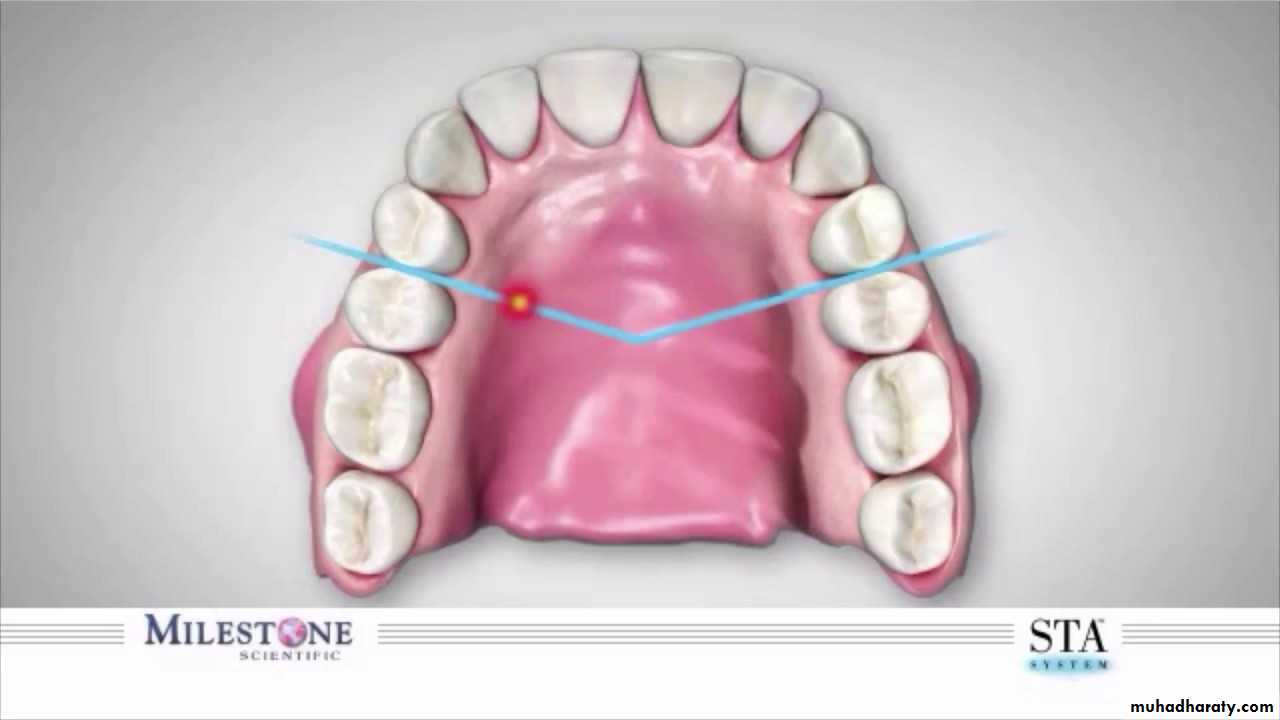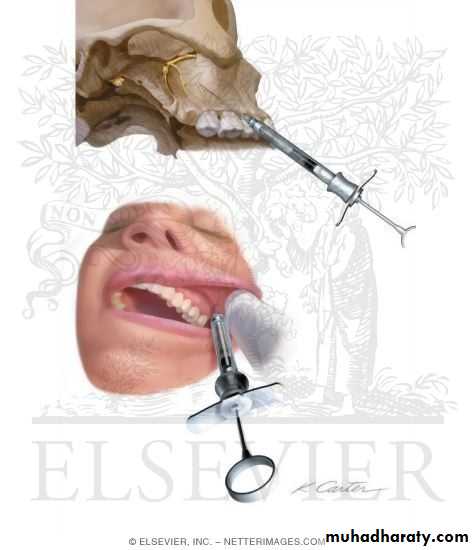Local anesthesia techniques
Bahoz Himdad Majeedinferior alveolar block
Technique of choice for mandibular molars; also effective for premolars, canines, and incisors.The patients mouth must be widely open.
Palpate the landmarks of external and internal oblique ridges and note the line of the ptyerygomandibular raphe.With the palpating thumb lying in the retromolar fossa, the needle should be inserted at the midpoint of the tip of the thumb slightly above the occlusal plane lateral to the ptyerygomandibular raphe.
The needle is inserted ~0.5 cm and if a lingual nerve block is required 0.5 ml of LA is injected at this point.
The syringe is then moved horizontally across the dorsum of the tongue and advanced to make contact with the lingula.
Once bony contact is made the needle is withdrawn slightly and the remainder of the LA injected.
Note that the mandibular foramen varies in position with age. In the edentulous, the foramen, and hence the point of needle insertion, is relatively higher than in the dentate.
Successful execution of this technique results in anesthesia
Mandibular teeth to midlineBody of mandible, inferior ramus
Buccal mucosa anterior to mental foramen
Anterior 2/3 tongue & floor of mouth
Lingual soft tissue and periosteum
Akinosi Technique
LA deposited above linguaClosed-mouth technique
Does not rely on a hard-tissue landmark
Parallel to occlusal plane, height of the mucogingival junction Advanced until hub is level with distal surface of maxillary second molar
Delayed onset of anaesthesia
Gow-Gates technique
The Gow-Gates technique is useful alternative to the inferior alveolar nerve block and is often used when the latter fails to provide adequate anesthesia.Advantages of this technique versus the inferior alveolar technique are its low failure rate and low incidence of positive aspiration.
The Gow-Gates technique anesthetizes the auriculotemporal, inferior alveolar, buccal, mental, incisive, mylohyoid and lingual nerves.
Mental nerve block
Mental nerve block The mental nerve emerges from the mental foramen lying apical to and between the first and second mandibular premolars.LA injected in this region will diffuse in through the mental foramen and provide limited analgesia of premolars and canine, and to a lesser degree incisors on that side. It will provide effective soft-tissue analgesia.
Place the lip on tension and insert the needle parallel to the long axis of the premolars angling towards bone, and deposit the LA.
Do not attempt to inject into the mental foramen as this may traumatize the nerve.
LA can be encouraged in by massage.
Buccal Nerve Block
The buccal nerve is not anesthetized by an inferior alveolar nerve block.This nerve innervates the tissues and periosteum buccal to the molars, so if these soft tissues are involved in treatment, the buccal nerve should be injected as well.
The additional injection is unnecessary when treating only the teeth.
A 25 gauge long needle is recommended
The needle is inserted in the mucous membrane distal buccal to the last molar
Insert the needle to 2 to 4 mm to gently contact bone, and aspirate. If negative, slowly deposit about 1/8 of the solution in the cartridge.
Sublingual nerve block
Sublingual nerve block An anterior extension of the lingual nerve can be blocked by placing the needle just submucosally lingual to the premolars, use 0.5 ml of LA.Nasopalatine block
Nasopalatine block Profound anaesthesia can be achieved by passing the needle through the incisive papilla and injecting a small amount of solution.This is extremely painful
Infra-orbital block
Infraorbital nerve block is a useful technique for achieving anesthesia of the maxillary central and lateral incisors, canine,1st and 2nd premolars and mesial rooth of 1st molar as well as the surrounding soft tissue on the buccal aspect.Infra-orbital block
Infra-orbital block Rarely indicated.A 25 gauge long needle is recommended and inserted with the bevel toward the bone in the muco-buccal fold over the first premolar.
Palpate the inferior margin of the orbit as the infra-orbital foramen lies ~1 cm below the deepest point of the orbital margin. Hold the index finger at this point while the upper lip is lifted with the thumb.
Inject in the depth of the buccal sulcus towards your finger, avoid your finger, and deposit LA around the infra-orbital nerve.
Anterior Middle Superior Alveolar Block
If the infraorbital nerve block does not provide adequate anesthesia to the teeth distal of the canine or if the PSA injection does not provide anesthesia for the mesiobuccal root of the first molar, an MSA block injection should be administered.A 25 gauge short needle is recommended with insertion in the mucobuccal fold by the maxillary second premolar.
About 1/2 to 2/3 of a cartridge of anesthetic is slowly deposited at the height of the apex of the second premolar after negative aspiration
One injection site - Central to second premolar, palatal and buccal soft tissue Is used to anesthetize pulp tissue and facial periodontium of the maxillary premolars and the mesiobuccal root of the first molar in some cases.
Posterior superior alveolar block
is a commonly used technique for achieving anesthesia for the maxillary molarsPosterior superior alveolar block A rarely indicated technique.
The short 25 or 27 gauge needle is recommended to decrease the risk of a hematoma
Needle is inserted distal to the upper second molar and advanced inwards, backwards, and upwards close to bone for ~2 cm.
LA is deposited high above the tuberosity after aspirating to avoid the ptyerygoid plexus
Greater Palatine Nerve Block
The greater palatine nerve innervates the palatal tissues and bone distal of the canine on the side anesthetized.Use a 27 gauge short needle with the bevel toward the palate.
Palpate the palate until the depression of the foramen is felt (usually somewhere medial to the second molar).
Dry the tissue, and apply antiseptic and topical anesthetic for 2 minutes. Apply pressure with the swab for 30 seconds.
Continue pressure with the swab until the injection is completed.
Place the bevel against the tissue and apply pressure enough to slightly bow the needle.
Inject a few drops of anesthetic.Release the pressure of the needle and advance the tip of the needle into the tissue slightly.
Continue with this procedure of applying pressure to the bevel and depositing a few drops of anesthetic, then advancing, until the needle is in contact with the palatal bone.
Deposit less than a fourth to a third of a cartridge of anesthetic after negative aspiration is proven
Maxillary Nerve Block
The maxillary (V2) nerve innervates half of the maxilla, including the buccal and palatal aspects.This injection technique is used especially in quadrant surgery or when extensive treatment is indicated for a single appointment.
It is also used when another site of injection has failed or if there is an infection in the area
this technique is used more with adult patients. It is not for the inexperienced.
Administration through the buccal aspect involves the possibility for hematoma.
The long 25 gauge needle is recommended with the bevel of the needle facing the bone.
The needle is inserted at the mucobuccal fold near the distal of the second molar after the usual protocol of tissue preparation.
The path of the needle is similar to that of the PSA nerve block, but is inserted approximately 30 mm to the pterygopalatine fossa.
Aspirate, then rotate the needle bevel 1/4 turn, reaspirate. If both aspirations are negative, slowly deposit one cartridge of anesthetic (deposit 1/4 then aspirate, then deposit 1/4 until the entire cartridge has been administered).

